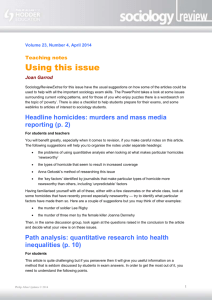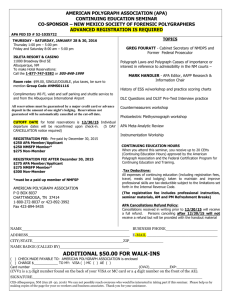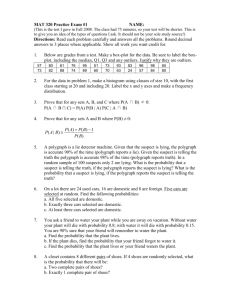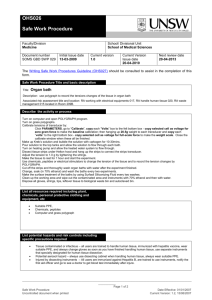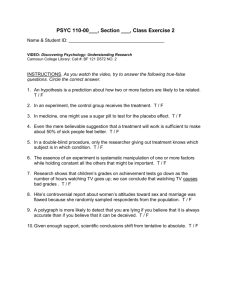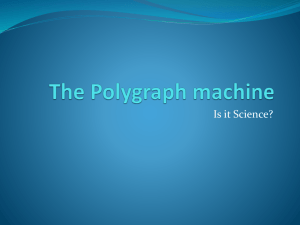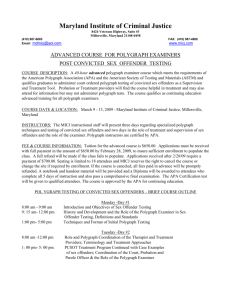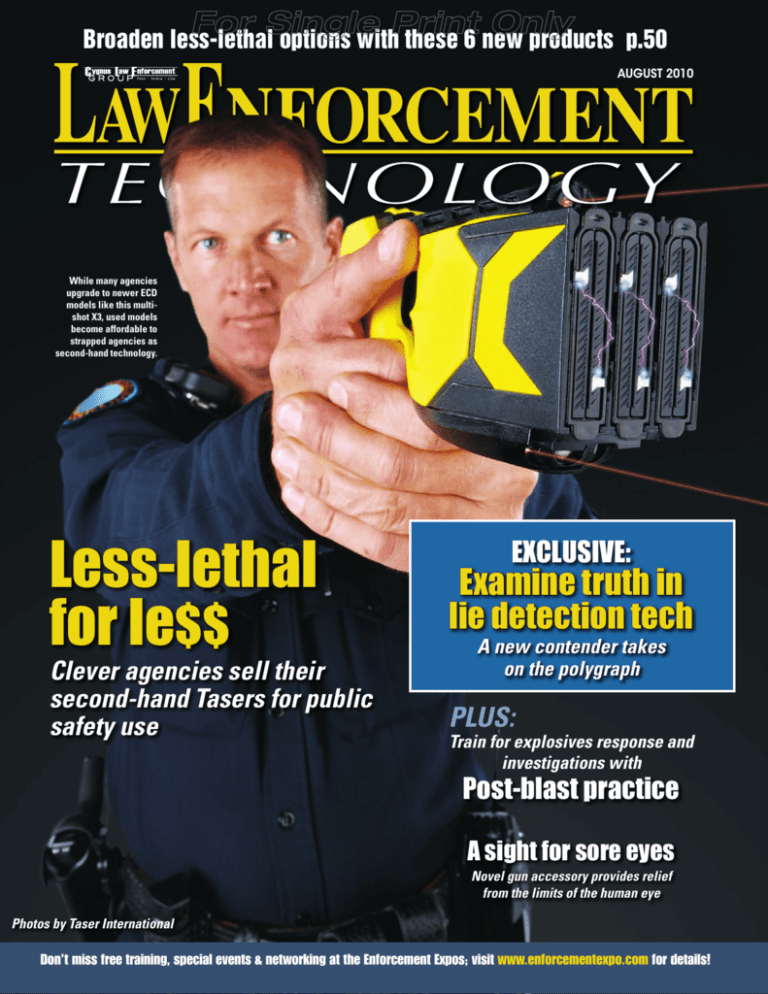
Broaden less-lethal options with these 6 new products p.50
AUGUST 2010
While many agencies
upgrade to newer ECD
models like this multishot X3, used models
become affordable to
strapped agencies as
second-hand technology.
Less-lethal
for le$$
Clever agencies sell their
second-hand Tasers for public
safety use
EXCLUSIVE:
Examine truth in
lie detection tech
A new contender takes
on the polygraph
PLUS:
Train for explosives response and
investigations with
Post-blast practice
A sight for sore eyes
Novel gun accessory provides relief
from the limits of the human eye
Photos by Taser International
Don’t miss free training, special events & networking at the Enforcement Expos; visit www.enforcementexpo.com for details!
A new contender takes
on the polygraph
By Rebecca Kanable
truth
The
surrounding
lie detection technology
T
o look at truths relating to lie detection seems ironic.
Machines designed to detect human deception have for
one reason or another kept innocent people free and led to
criminal confessions and convictions. How or why has caused
much debate. Yet, applications of these machines have
broadened. As polygraph and voice stress analysis
technologies continue to advance, they bring with them
controversy and concern.
Law enforcement has been using a machine to help detect
lies since 1920 when John Larson, a Berkeley (Calif.) police
officer with a Ph.D. in physiology used a machine to simultaneously chart breathing and blood pressure. Modern-day
polygraphs also record physiological activities as “many writings.” The American Polygraph Association (APA), founded
2
Law Enforcement Technology
■
August 2010
■
www.officer.com
in 1966, describes today’s polygraph
examination: “Convoluted rubber
tubes are placed over an examinee’s
chest and abdominal area to record
respiratory activity. Two small metal
plates are attached to fingers to record
sweat gland activity. And a blood pressure cuff, or similar device, records
cardiovascular activity.”
APA emphasizes that a valid examination requires the combination of a
properly trained examiner, a polygraph
instrument that records cardiovascular,
respiratory and electrodermal activity,
and the proper administration of an
accepted testing procedure and scoring
system.
APA President Daniel Sosnowski
has been doing polygraph examinations for 30 years and witnessed the
polygraph evolve from an analog
to a more efficient and accurate digital
instrument.
The polygraph is used by law
enforcement agencies, the legal com-
munity and the private sector. More
than 2,800 people from 25 countries are
APA members. In law enforcement, the
polygraph assists in the investigation of
criminal conduct. For the purposes of
general admissibility at trial, polygraph
evidence is not typically admissible.
New Mexico is the exception, says APA
general counsel Gordon Vaughan, and
many other states accept polygraph
evidence, but only by stipulation of the
parties.
The polygraph is also used to screen
police candidates. The Employee
Polygraph Protection Act of 1988 generally prevents employers from using
lie detector tests for pre-employment
screening or during the course of
employment. Federal, state and local
governments, however, are excluded.
Increasingly, Vaughan says he is seeing courts accept polygraph evidence
not only in pre-trial matters, but in
the monitoring of convicted criminals,
often sex offenders, under probation
The National
Institute
for Truth
Verification
founder was
awarded
a second
patent for the
Computer
Voice Stress
Analyzer in
2009.
and parole restrictions. Sosnowski
was recently asked to give a polygraph
examination in a federal death penalty
case. The accused said he was innocent
and passed the exam. Based on that
and other circumstantial evidence, the
man was spared the death penalty.
“That’s what we constantly strive for,”
Sosnowski says.
Often the news media report on bad
polygraph exams, but he says, “what we
don’t hear about is the polygraph saving someone from being fired or going
to jail.” Even in 2010, Sosnowski says
there are many misconceptions about
the polygraph. Addressing one, he
explains: “You’re never going to fail the
polygraph just because you’re nervous,
because nervousness is going to be consistent throughout the entire process.”
Another misconception is based on
TV, where a polygraph examination
may only take 5 minutes. He says the
reality is examinations take a minimum
of 2 to 3 hours.
The polygraph continues to face
controversy and adversaries: anti-polygraph Web sites claim to teach people
how to cheat the polygraph and accuracy rates given for polygraph exams
often are disputed. APA’s compendium
of research studies with 80 research
projects support accuracy rates beginning at 80 percent.
The 2003 National Academy of
Sciences (NAS) report looked at some
of those studies. In “The Polygraph
and Lie Detection,” NAS found the
majority of polygraph research was
unreliable, unscientific and biased. APA
points out NAS’ effort was confined to
a review of the research on polygraph
testing and in particular, polygraph
testing as it relates to personnel screening. APA says NAS relied on only 57
of the more than 1,000 research studies
available. In a chart looking at security
screening, NAS comes up with a false
positive rate of almost 16 percent.
Among its overall findings, NAS
says, “Almost a century of research in
scientific psychology and physiology
provides little basis for the expectation that a polygraph test could have
extremely high accuracy. The physiological responses measured by the
polygraph are not uniquely related to
deception.”
While NAS says the expectation for
polygraph test accuracy may not be
extremely high, it is higher than using
only human judgment, which is close to
chance, says Maria Hartwig, who holds
a Ph.D. in psychology and is an assistant professor of psychology at John
Jay College of Criminal Justice in New
York. She says polygraph results are
typically around 75 percent accurate.
Hartwig, who emphasizes she does
not think the polygraph is the ultimate
lie-detecting tool, adds accurate, higherthan-chance results are possible when
a trained polygraph examiner uses a
standardized approach and accepts the
results for what they are.
Discrepancies occur when looking
at polygraph effectiveness, because different polygraph tests have different
question protocols. Another reason for
discrepancies: Inconclusive test results
are sometimes classified as errors. APA
says in real life, an inconclusive result
— meaning an examiner is unable to
render a definite diagnosis — is not
typically included by polygraph examiners when measuring accuracy.
Knowing the polygraph is not perfect and has had high-profile cases in
which criminals who passed the polygraph were later found guilty, APA says
it welcomes the NAS recommendation
for additional research and greater
innovation in the field. Commenting
on potential alternatives to the poly-
graph, NAS says, “Some show promise, but none has yet been shown to
outperform the polygraph. None shows
any promise of supplanting the poly-
“Remember: not all
are guilty and we are
looking for the truth.”
— James Chapman, education and
standards director at NACVSA
graph for screening purposes in the
near term.”
Polygraph vs. voice stress
Polygraph examiners and
voice stress examiners often find
themselves commenting on
the other.
For years, polygraph examiners have
been saying voice stress does not work,
and have been accused of doing so to
protect their turf. Sosnowski says that’s
not the reason. “If research clearly
showed that voice stress worked, that it
truly stood up to scientific scrutiny, we
would embrace it,” he says. “We would
make it an additional parameter to the
polygraph test.”
One of the most critical and most
recent papers opposing the use of
voice stress analysis was published in
the International Journal of Speech,
Language and the Law in 2007. The
article states there is no scientific evidence to support the idea that microtremors in the 10 Hz region occurs in
muscles involved in speech production
for voice stress analysis. But since a
company (not named in this article)
alleging defamation requested a retraction, the journal’s publisher, Equinox
Publishing, has removed the article
from its Web site.
www.officer.com
■
Despite the arguments, the National
Institute for Truth Verification (NITV)
estimates about 1,800 local, state and
federal law enforcement agencies are
using its patented Computer Voice
Stress Analyzer (CVSA) products. As
with the polygraph, results of voice
stress analysis are not normally used
in court, but help eliminate individuals
as suspects, and voice stress analysis
is being required for probation and
parole, particularly with sex offenders.
In addition, NITV has trained more
than 400 military CVSA examiners,
and the CVSA is still being used by
military units in combat zones.
James Chapman, education and
standards director of the National
Association of Computer Voice Stress
Analysts, (NACVSA) asks: How can
all these agencies and people be wrong?
Chapman is professor emeritus
and former director of the Criminal
Justice Program and Forensic Crime
Laboratory at the State University
of New York in Corning. Prior to
his career in education, he served in
law enforcement and the U.S. Marine
Corps.
While others may argue there is not
enough scientific evidence to demonstrate voice stress analysis is a science,
Chapman emphatically states the
debate is over. He says VSA technology is an accurate, reliable and legally
sound truth verification tool. And,
he adds, CVSA has no inconclusive
results.
Voice stress analysis has its origins
in the work of three former U.S. Army
commanding officers. The first system became commercially available
in 1971 and Chapman has been using
voice stress analysis since then. As a
criminologist, he had been looking
for an investigative tool applying to
both natural and behavioral science.
August 2010
■
Law Enforcement Technology
4
Specifically, he was looking for a testing platform to evaluate the spoken
word, not yes or no (like the polygraph), but multi-utterances. He also
wanted a test that would treat fellow
human beings with dignity and respect,
which he says would not involve “wiring people up” or touching them.
“Remember: not all are guilty and we
are looking for the truth,” he adds.
After 39 years of conducting voice
stress analysis and a 19-year study,
Chapman’s work has resulted in a
confession rate of more than 95 percent. In five cases where there were 18
homicides and one suicide, the suspects
passed a polygraph examination and
were cleared. They were then re-tested
using voice stress analysis and the suspects did not pass the exam. All cases
and suspects were successfully adjudicated. “Most importantly,” he says,
“VSA testing was able to accurately
identify innocent individuals who were
suspected of wrongdoing, thus removing them from suspicion.”
The results, he says, are not surprising when you understand what
voice stress analysis can do. While the
polygraph displays only relative stress,
Chapman says voice stress analysis displays absolute stress. He explains voice
stress analysis detects levels of significant emotional stress from human
voice utterances. The benefits to not
having attached sensors are eliminating
any stress they might cause and being
able to do remote analysis.
Chapman has conducted numerous
examinations in person and using tape
recordings, communication intercepts
and telephone interviews. He has
published his findings in medical and
forensic journals and is working on
publishing the results of 19 years of
field study.
“There was tremendous oversight
5
Law Enforcement Technology
■
to the research process I utilized —
namely in the form of legal, constitutional guarantees,” he describes.
“From reasonable suspicion to investigation, to probable cause to arrest
and indictment, to trial and conviction or acquittal, I know of no other
longitudinal field study with such a
seamless, intense oversight mechanism
to assure an impartial and legally valid
outcome.”
John Trice retained Chapman on
many different cases when Trice was
district attorney for Chemung County
(N.Y.) from 2000 to 2008, and was
an assistant DA from 1984 to 1998.
He says he has a lot of confidence in
the machine because he’s seen it work
in many cases. He describes one case
that stands out in his mind: Person
A, a bank robbery suspect, told police
that Person B was the robber. A CVSA
exam resulted in Person A admitting he
lied and he, Person A, was the one who
robbed the bank. CVSA results, along
with corroborating evidence, exonerated Person B and all criminal charges
against him were dropped. Trice adds
he’s never seen it fail, and he knows of
no known counter measures.
On the NITV Web site, detectives
list case after case solved with the help
of the CVSA. NITV has been selling
voice stress analysis technology since
1988. From that time up until 1997,
only an analog version of the instrument was available. The first softwarebased CVSA was introduced in 1997
and the CVSA II came out in 2007
with the addition of the Final Analysis
Confirmation Tool Scoring System, the
simplification of examiner interfaces to
reduce the time required for conducting examinations, and the capability
to record live and telephonic examinations directly to the hard drive.
NACVSA was created to offer train-
August 2010
■
www.officer.com
ing and representation to law enforcement and others who use the CVSA
to conduct truth verification examinations. CVSA examiners are required
to recertify every two years. NACVSA
members also assist each other with
cases. For example, examiners who
join NACVSA’s L-List can ask for help
with charts, question formulation and
examination formats.
Real jeopardy
To those in the academic community who say the science of voice stress
does not work, Chapman says the crux
of the matter is real jeopardy, which is
what he’s using, vs. artificial jeopardy
found in the laboratory setting.
The instrument was never designed
to measure artificial jeopardy, stress
measurements of game situations, so
scientists will not be successful with the
instrument in a laboratory setting. As
a laboratory scientist, Hartwig is not
sympathetic to the argument that the
nature of deception or real stress can’t
be replicated in the laboratory.
She says the criticism that labs can’t
be used to capture real-life deception is
based on a strange idea that as stakes
increase, it becomes difficult to lie.
Hartwig says the truth-telling person
is under the same pressure as someone
who is lying. Chapman maintains that’s
not right because a person lying about
having picked the two of spades from a
deck of cards cannot produce the same
level of stress as a woman suspected of
cutting the throat of her 3-month-old
baby.
The best research model for testing
lie detection is operational research, he
says.
He explains: “Operational research
is one of those ways, and can differ
from both hard and soft science measurement in analyzing primary data in
case studies. That research approach
is more suited to the CVSA than any
other, and it can literally make the
case for the CVSA through proper
analytic presentation and interpretation. Traditional academic statistical
research methodology is too often
based on secondary analysis that cannot demonstrate the primary personal
technology nexus that’s required in testing VSA. An example of marksmanship, in the analogy of hitting the truth
target, the accuracy of the weapon
depends upon the skill of the person
using it.”
It is here, somewhere along these
lines and graphs, that voice stress and
polygraph agree.
APA points out NAS and APA
recognize the field of lie detection is a
difficult one to quantify or measure in
terms of real-world effectiveness. NAS
reports real-world conditions are difficult, if not impossible, to replicate in a
mock crime or laboratory environment
for the purpose of assessing effective-
ness.
As a result, APA says, “A paradigm
for research into the validity and efficacy of lie detection has always been,
at best, a difficult challenge.” ■
Rebecca Kanable is a freelance writer
specializing in law enforcement topics. She can be reached at kanable@
charter.net.
For more information on what 1,800 law enforcement agencies call “One of
the most important investigative tools available today” please contact:
NITV Federal Services, LLC
11400 Fortune Circle
West Palm Beach, FL 33414
Toll Free: 888-266-7263
Phone 561-798-6280
National Association of Computer
Voice Stress Analysts
16192 Coastal Highway
Lewes, DE 19958-9776
Toll Free: 888-358-5025
Reprinted with permission from Law Enforcement Technology. Copyright ©2010. All rights reserved.
#1-28013516 Reprinted by The YGS Group, 717.505.9701. For more information visit www.theYGSgroup.com/reprints.

